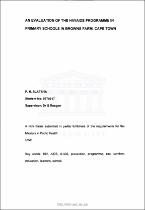| dc.description.abstract | Aim: To compare knowledge and reported behaviour related to HIV/AIDS between primary school students who attended schools where a Health Care Trust HIV/AIDS programme was run and those who attended schools without such a programme.
Objectives: To compare amongst youth in primary schools with an HIV/AIDS and schools without: Knowledge about the HIV/AIDS Programme of Health Care Trust, Knowledge of HIV/AIDS and STDs, Perceived risk and perceived role of individuals, Attitudes towards condom use, Attitudes towards people living with AIDS, Sexual behaviour, Access to condoms and condom use. Setting: The study takes place in primary schools in two informal settlements, (Browns Farm and Samora Machel) in Cape Town. Methodology Study Design: This was a cross-sectional descriptive study comparing the students who attended schools where a Health Care Trust HIV/AIDS programme was run and those who attended schools without such a programme. Study Population: All youth (697) in standard five in primary schools in Browns Farm and primary schools in Samora Machel. Sample Size: Sample size was calculated using EPI INFO. The sample size was 176 students. Sampling Procedure: From the four schools that have received AIDS education from the programme, two were randomly selected as the programme group. The comparison group consists of students from the new school in Browns Farm and a randomly selected school in Samora Machel with similar socio-economic conditions as Browns Farm. Data Collection: An interviewer-administered questionnaire was designed for data collection based on the objectives. Results: A total of 176 students,51% females and 49% males participated in the study' The mean age of the students was 14.5 with a range of 11- 20 years. Amongst the programme group knowledge about the programme was 84%. Knowledge of HIV/AIDS was high, 98% in the programme group and 97% in the comparison group with a prevalence ratio of I and (0.96-1 .0) 95% confidence interval. STD knowledge was 22% for the programme group and 78%o for the comparison group. One third of the students, 38%, (31% programme group and 45% comparison group prevalence ratio 0.68 and (0.46-0.9) 95% confidence interval were sexually active. Of these students 12% have used a condom (19% programme group and 8% comparison group) with the programme group influenced by the programme. They all had no problems with condom use. Students in both groups have a negative attitude towards people living with AIDS. Conclusion Students at the school where the HIV/AIDS programme was run, did not have greater knowledge nor did they have more appropriate behaviour than the students in the comparison group. Youth in primary schools are sexually active and therefore at risk of contracting HIV and other STDs. They know about condoms but are not using them. This stresses the need for AIDS education programme to target primary schools as by the time they reach high school it may be too late. Although this programme has been of limited effectiveness the importance and value of AIDS education in schools, cannot be dismissed. it is probably more appropriate to look at the reasons why the programme had only a limited effect and remedy the deficiencies. | en_US |

